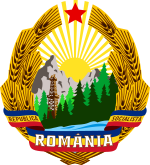
| Part of a series on the |
| Socialist Republic of Romania |
|---|
 |
The collectivization of agriculture in Romania took place in the early years of the Communist regime. The initiative sought to bring about a thorough transformation in the property regime and organization of labor in agriculture. According to some authors, such as US anthropologist David Kideckel, agricultural collectivization was a "response to the objective circumstances" in postwar Romania, rather than an ideologically motivated enterprise.[1] Unlike the Stalinist model applied in the Soviet Union in the 1930s, the collectivization was not achieved by mass liquidation of wealthy peasants, starvation, or agricultural sabotage, but was accomplished gradually. This often included significant violence and destruction as employed by cadres, or Party representatives.[2]
The program was launched at the plenary of the Central Committee of the Romanian Workers' Party of 3–5 March 1949, where a resolution regarding socialist transformation of agriculture was adopted along the lines of the Soviet kolkhoz.[3] The collectivization strategy covered two directions: model collective structures were set up, such as Gospodării Agricole Colective (GAC; Collective Agricultural Institutions) and Gospodării Agricole de Stat (GAS; State Agricultural Institutions), aimed at attracting peasants; and the full propaganda system (newspapers, radio, mobile caravans, brochures, direct action by agitators) was put in motion in order to convince peasants to form collective farming units. A problem that the Party encountered with written propaganda was the high rate of illiteracy amongst the Romanian peasantry. In order to combat this, the Party engaged in a campaign to increase literacy amongst the peasants.
The communist ideology clashed with the traditional hierarchical structures of the Romanian villages, which were not egalitarian. Many of the village elites were godparents or patrons for poor peasants, providing them access to land in return for their labor. Many in the lower classes aspired to join the educated elite, and prosperity was seen as a sign of virtue and hard work.[4]